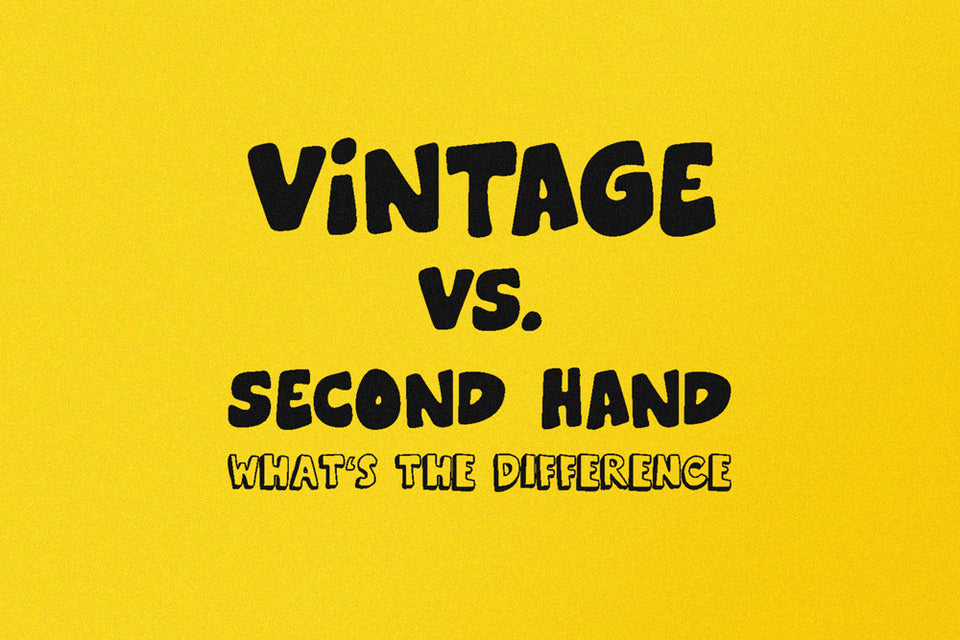
All Things Vintage: Vintage Vs. Second Hand
Vintage vs. Secondhand: Which is Which
There's hardly a question we hear more often: "What's actually the difference between vintage and second hand?" We'll explain! To separate the two terms, let's first take a look at them individually. Spoiler alert: If you don't want to dive quite that deep into the vintage world, there's a handy summary at the end of the article.This is Second Hand
Second Hand clothing has two advantages: you can save money and it's not needed to produce new clothes. You can find them in Second Hand stores, which can be found in every bigger city. But you should bring time with you: The selection is often somewhat random and from baby clothes to grandpa pants in XXXL, everything can be there. However, treasures can occasionally be found here - but you have to have a lot of patience and luck.
This is Vintage
"Vintage" can sometimes be translated as "old", among other things. Which brings us to the first big difference to second hand: If something is vintage, it must be at least 20 years old.
The term "vintage" says nothing about the condition of a piece: A vintage piece can be worn-out as well as in perfect new condition. If, for example, our treasure hunt turns up old stocks of caps from the 90s - still with price tags on them - they are vintage because of their age. But they are not second hand: In this case they come from old warehouses directly into our store after our quality-check. So they have never been worn and have not passed through any "hand" of a customer.
Vintage: less resources, more quality
Vintage can also be kinder to the environment because you're using clothes that already exist (instead of supporting new ones being made). Another bonus of vintage: if clothing (when worn) has already survived well for a period of at least 20 years, that definitely speaks to better quality than that of today's pieces. And it's actually true: clothing used to be often finished to a higher quality so that it would last longer.
Here you can find vintage
On the topic of "price", we come right after the question of "where": vintage clothing can be found online, but slowly also in some stores here in Germany - for example in our store in Mannheim. The big difference to second hand stores is the selection: Vintage stores only have vintage pieces. Nothing smells musty (as can happen in second hand stores). And in a vintage store, a pre-selection has already taken place: You won't find the aforementioned grandpa pants here, but only finely selected pieces.
By the way, it's no coincidence that "vintage" can also mean "selection": only special pieces find their way into a vintage store. Inferior clothing, T-shirts with ugly prints from bachelor parties and the like are sorted out beforehand or not even taken along on the treasure hunt.
Vintage: Sometimes more expensive, because rare
Which brings us to the price factor: Vintage clothing, if you find it at the flea market, can be very cheap. In vintage stores, vintage can sometimes cost a bit more. If the price is higher, several factors can play a role: The degree of rarity - because some brands have not produced anything for a long time, for example. Also high-quality materials such as wool or silk can influence the price.
Condition is also important, whether in unworn "deadstock" condition or totally rocked. A special patina or fade, i.e. the individual traces of wear, can namely increase the value of a piece even more: for example, some vintage pieces have a unique look and feel that can only be created by years of wear. This is how the piece tells its own story - we love that at Double Double. Another thing to keep in mind is that sometimes you pay for the time that sellers invest in searching, sorting, washing, and refurbishing. But you save these points yourself.
PS: By the way, "retro" is an umbrella term for newly produced pieces that only imitate the look or motifs of vintage clothing. You won't find such pieces at Double Double Vintage, as the "vintage" in our name suggests.
"Second hand" vs. "Vintage": summarized again
What is second hand?
- Had another owner before (mostly worn)
- Age does not matter
- Saves money
- Better for the environment
What is Vintage?
- Worn or in new condition
- At least 20 years old
- Rarer (and therefore sometimes more expensive)
- Often produced in higher quality
- Better for the environment